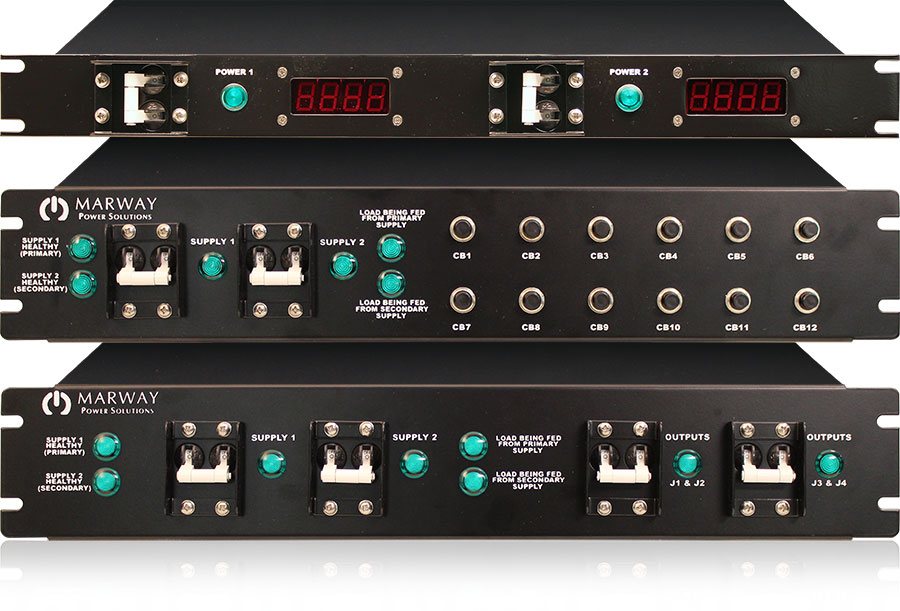TwinPower™ ATSs
Product SelectorCoping With Loss ↑
An Automatic Transfer Switch (ATS) enables critical equipment to have both a primary and a secondary power feed. By default, equipment is powered by the primary feed. If the primary power fails, the ATS automatically switches to the secondary power feed. This ensures that critical equipment is provided with power, even if the primary power feed fails.
Marway’s ATS products use a “break before make” switching mechanism. This technique ensures isolation of the two power feeds, and eliminates a requirement for the two power feeds to be phase synchronized. This type of auto transfer switching is used mostly when there is a UPS between the ATS and PDU, or for equipment which, though powered, may not be actively engaged in work 100% of the time, or would otherwise not lose functionality due to a power loss lasting just under 20 milliseconds.

Standard or Custom ↑
- Standard models for 120 Vac and 208 Vac, 30 amps.
- Integrated EMI filter and surge suppression.
- Outlet types include 5-20, L5-20, L5-30, L6-30, C13, C19
There are several pre-designed models to choose from offering a variety of inlet types, power loads, controls, and outlets. In some cases, models include multiple outlets and other features to effectively be the ATS and the PDU in one unit.
As with all Marway products, we specialize in optimizing a design to incorporate the exact features needed for your application. For an auto-transfer switch, that could include extra control or monitoring, a unique mixture of outlet types, or power input signal conditioning.

When to Use an ATS ↑
There are numerous possible scenarios, but it may help to contrast two basic scenarios to help explain when the ATS is a useful power management tool.
Let’s start with an example where an ATS is not typically needed—a rack of computer servers in a modern data center with completely redundant power grids in the building. Most modern servers feature dual power supplies. One power supply is connected to power grid A, and the other to power grid B. This setup has two power sources, and the equipment itself already has two power inputs. Since there’s redundancy built in from end to end, an ATS is not needed here.
Now, let’s consider a group of industrial equipment where each piece has a single power input (which is almost always the case). Whether the facility has dual power grids, or the installation simply requires alternative power supplied from two separate breaker panels, the equipment cannot accept the dual power sources. This is where the ATS comes in. The two power sources are connected to the ATS. The ATS is connected to, or incorporates, power distribution to each piece of equipment. If one of the power sources fails, the ATS performs the task of switching to the secondary source.

ATS or UPS? Or Both? ↑
Does using an ATS mean you don’t need a battery backup system (a.k.a. Uninterruptible Power Supply)? No, the ATS and UPS have different jobs to do, and are used for different reasons. In fact, you may want to use both types of products at the same time.
A UPS is typically sized to provide power for a short period of time; typically, long enough to conduct a safe shutdown of the equipment depending on it. This may be a few minutes up to a few hours. In either case, a UPS does not provide redundant power. It provides an emergency dose of power for a short time. The difference between redundant and emergency power is important, and the needs of your equipment and environment must consider the benefits of providing each.
As stated, emergency power provides power for a short duration typically to ensure human safety, product safety, or even data safety. With a UPS, this emergency power would work even with the total loss of facility power, but not for long.
Redundant power through an ATS differs in that the intent is to guard against loss (or intentional shutdown) of a specific power source from within the facility. Using a second power source, power consumption may continue for extended periods of time. However, the ATS will not protect against a total loss of facility power.
These are two distinct power management needs, and each has a specialized piece of equipment to handle it. In some cases, you’ll want one or the other, or both.
